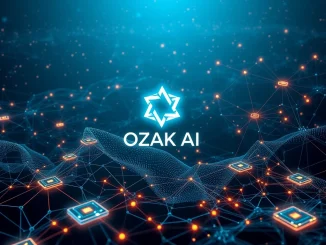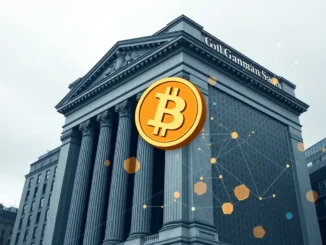
Whispers of unanswered questions and hidden vaults have long surrounded Fort Knox, the legendary repository of U.S. gold reserves. After nearly half a century without a comprehensive review, the clamor for a Fort Knox gold audit is growing louder, igniting a fascinating debate about the future of gold and its representation in the digital age. Could the solution to ensuring transparency lie in the innovative realm of blockchain and gold tokenization? Let’s delve into this captivating intersection of tradition and technology.
Why the Sudden Urgency for a Fort Knox Gold Audit?
For decades, the official U.S. gold reserves held at Fort Knox have remained largely unverified. This lack of recent auditing has fueled speculation and distrust, prompting figures like Elon Musk’s Department of Government Efficiency (DOGE) and Senator Rand Paul to raise serious blockchain transparency concerns. But why now, after all this time, is there such a strong push for an audit?
- Decades Without Review: It’s been roughly 50 years since a full-scale audit of Fort Knox’s gold reserves. In an era demanding accountability, this prolonged silence raises eyebrows.
- Growing Distrust in Institutions: Globally, there’s an increasing skepticism towards centralized institutions. A gold audit could either restore or further erode public trust in government holdings.
- Elon Musk’s DOGE and Political Pressure: Elon Musk’s involvement through DOGE, focused on government efficiency and transparency, has amplified the call for an audit, adding significant public and political pressure. Senator Rand Paul’s support further solidifies this momentum.
- Market Volatility and Economic Uncertainty: In times of economic instability, the security and verification of national assets like gold become paramount. An audit could reassure markets or expose vulnerabilities.
The urgency is palpable, and the outcome of this audit push could have significant implications for the perception of U.S. financial stability and the future of gold as an asset.
Tokenized Gold: A Blockchain-Based Solution for Transparency?
Enter gold tokenization, a concept gaining traction as a potential remedy for the very transparency issues highlighted by the Fort Knox audit debate. Michele Crivelli, COO of NexBridge, aptly points out the potential of blockchain to revolutionize how we verify and interact with gold reserves. Inspired by the rise of tokenized U.S. Treasurys, the idea of tokenizing gold is gaining serious consideration. But what exactly is tokenized gold, and how can it enhance transparency?
Understanding Gold Tokenization
Gold tokenization essentially involves creating digital representations of physical gold on a blockchain. Each token represents a fraction or a whole unit of physical gold, which is securely stored in vaults. This process brings several key advantages:
- Real-Time Verification: Blockchain’s immutable ledger allows for real-time tracking and verification of gold reserves. Every transaction and ownership change is recorded transparently and permanently.
- Increased Transparency: Tokenization makes it easier to audit and verify gold holdings. Instead of relying on infrequent physical audits, tokenized gold can be verified on the blockchain at any time.
- Fractional Ownership and Accessibility: Tokenization enables fractional ownership of gold, making it more accessible to smaller investors. Individuals can own a fraction of a gold bar represented by tokens.
- Enhanced Liquidity and Efficiency: Trading tokenized gold can be faster and more efficient than traditional physical gold trading, reducing transaction costs and settlement times.
Imagine a future where the gold reserves at Fort Knox, or any gold vault globally, are represented by tokens on a public blockchain. This would allow for continuous, independent verification of holdings, dramatically increasing transparency and trust.
The Benefits of Blockchain for Gold Verification
Why is blockchain technology particularly well-suited for enhancing the verification of gold reserves? Let’s break down the key benefits:
| Benefit | Description | Impact on Gold Verification |
|---|---|---|
| Immutability | Once data is recorded on a blockchain, it cannot be altered or deleted. | Ensures a tamper-proof record of gold holdings and transactions, preventing fraudulent activities. |
| Transparency | Blockchain ledgers are often publicly accessible, allowing anyone to view transaction history. | Enables public verification of gold reserves, reducing reliance on centralized authorities and opaque audits. |
| Decentralization | Blockchain networks are distributed across multiple nodes, eliminating single points of failure and control. | Reduces the risk of manipulation and enhances the security of gold reserve data. |
| Real-Time Tracking | Blockchain allows for instant recording and confirmation of transactions. | Provides up-to-date information on gold movements and holdings, enabling continuous monitoring. |
| Smart Contracts | Self-executing contracts on blockchain automate processes and enforce agreements. | Can automate audit processes, trigger alerts for discrepancies, and ensure compliance with regulations. |
These features combined make blockchain a powerful tool for creating a more transparent and accountable system for managing and verifying gold reserves.
Challenges and Considerations for Gold Tokenization
While the potential of gold tokenization is immense, it’s crucial to acknowledge the challenges and considerations that need to be addressed for widespread adoption:
- Regulatory Frameworks: Clear and consistent regulations are needed for tokenized assets. Governments and financial institutions must establish legal frameworks to govern the issuance, trading, and custody of tokenized gold.
- Custodial Solutions: Secure and reliable custodial solutions are essential to safeguard the physical gold backing the tokens. Trustworthy vaults and custodians are critical for investor confidence.
- Interoperability: Different blockchain platforms and tokenization standards may lead to fragmentation. Interoperability solutions are needed to ensure seamless trading and transfer of tokenized gold across platforms.
- Scalability: Blockchain networks need to be scalable to handle the potential volume of transactions associated with global gold markets.
- Public Perception and Education: Educating the public and overcoming skepticism about digital assets is crucial for broader acceptance of tokenized gold.
Addressing these challenges is vital for unlocking the full potential of gold tokenization and realizing its benefits for transparency and efficiency in the gold market.
Polymarket Prediction: Will the Audit Happen?
Adding another layer of intrigue to this unfolding narrative, Cointelegraph reports that Polymarket traders are placing bets on the likelihood of a Fort Knox audit actually happening. Currently, the prediction markets estimate a 50% chance of an audit by May. This highlights the uncertainty and the high stakes involved. Will the pressure mount sufficiently to compel an audit, or will Fort Knox remain shrouded in mystery?
Conclusion: A Golden Opportunity for Transparency
The convergence of calls for a Fort Knox gold audit and the rise of gold tokenization presents a pivotal moment for the gold industry. The demand for transparency in financial systems is undeniable, and blockchain technology offers a compelling pathway to achieve this, particularly in the realm of gold reserves. While challenges remain, the potential benefits of tokenized gold – enhanced transparency, real-time verification, and increased accessibility – are too significant to ignore. Whether or not the Fort Knox audit proceeds, the debate it has ignited is pushing the conversation forward, potentially paving the way for a more transparent and technologically advanced future for gold and beyond.



